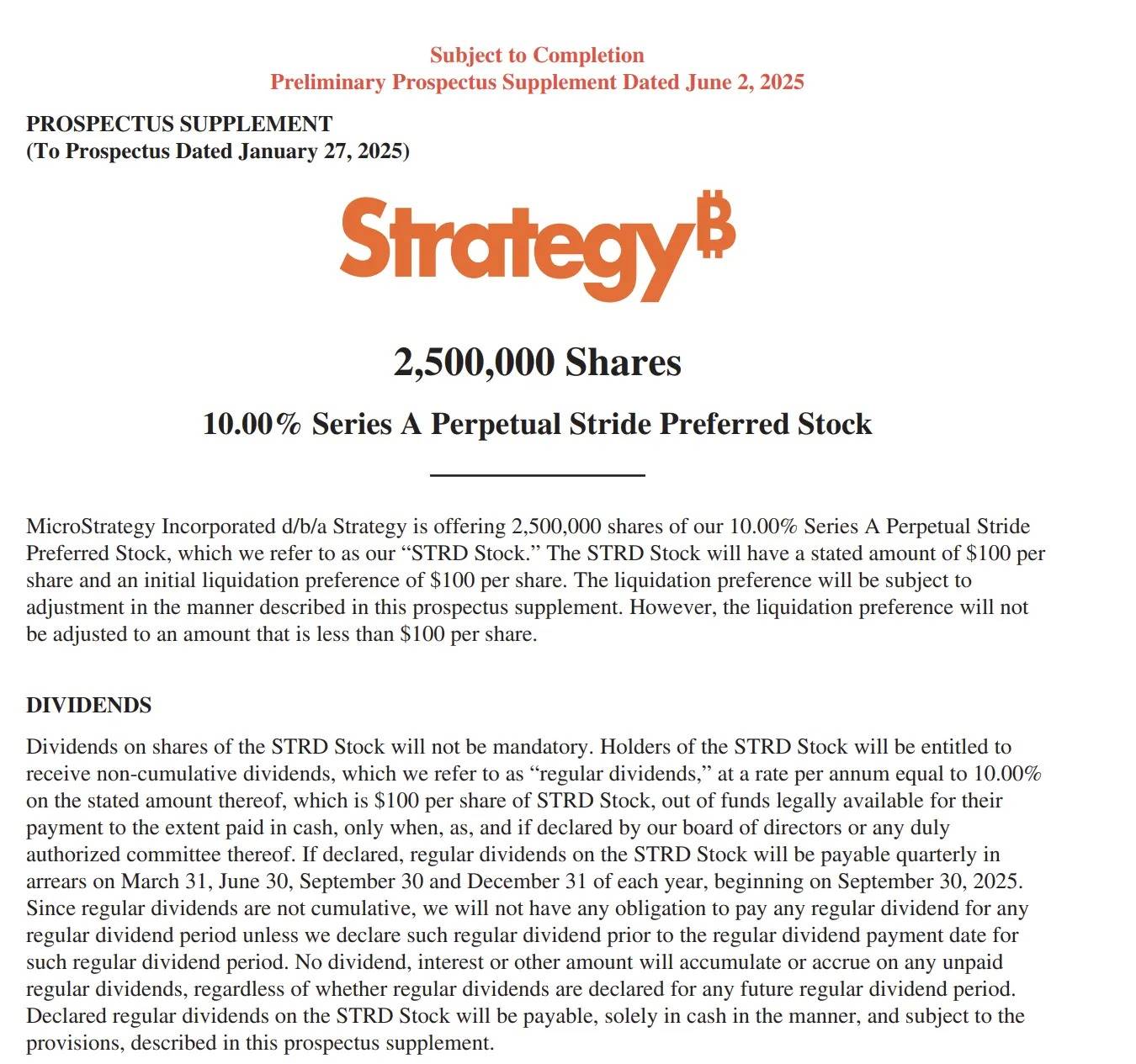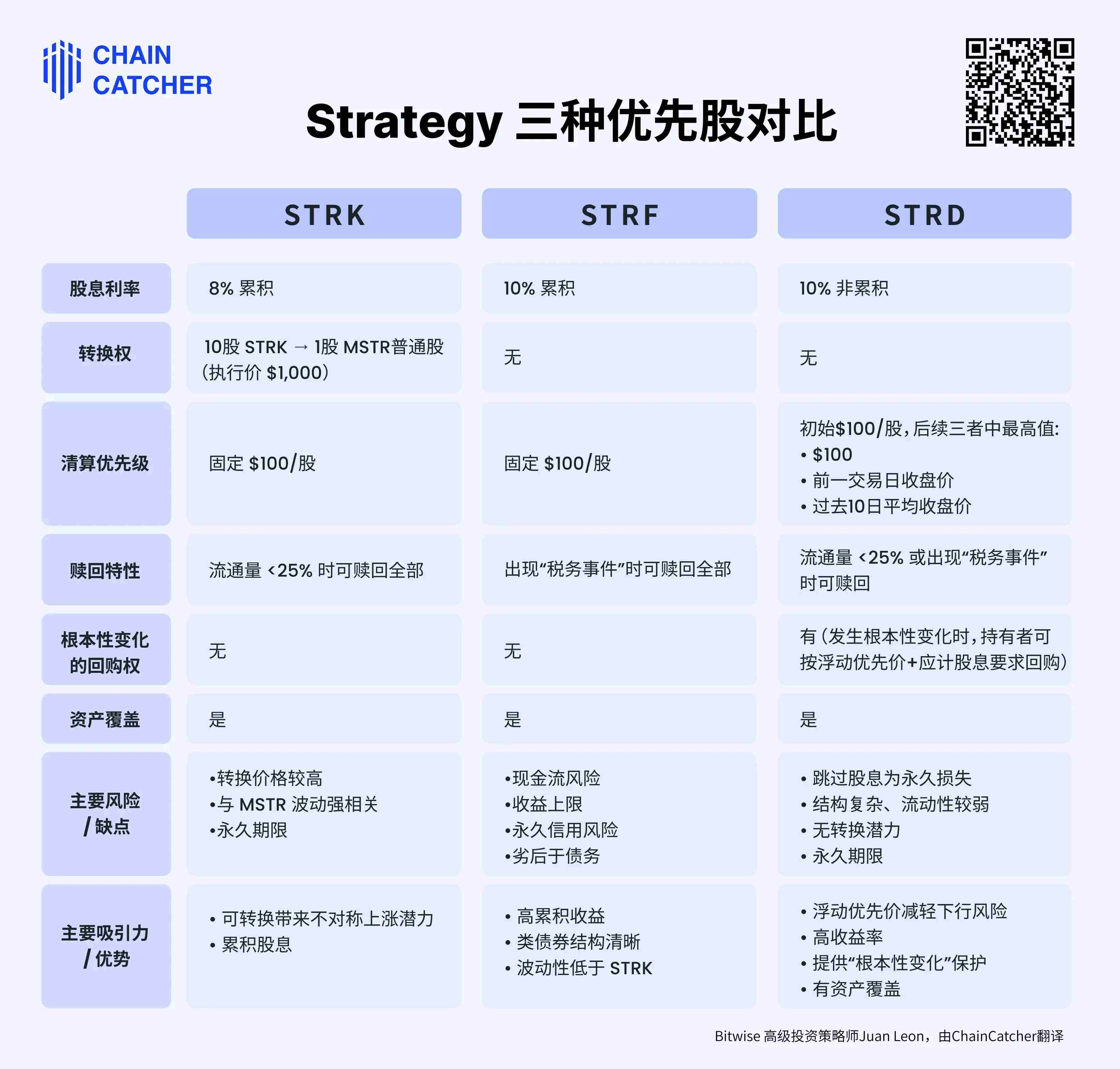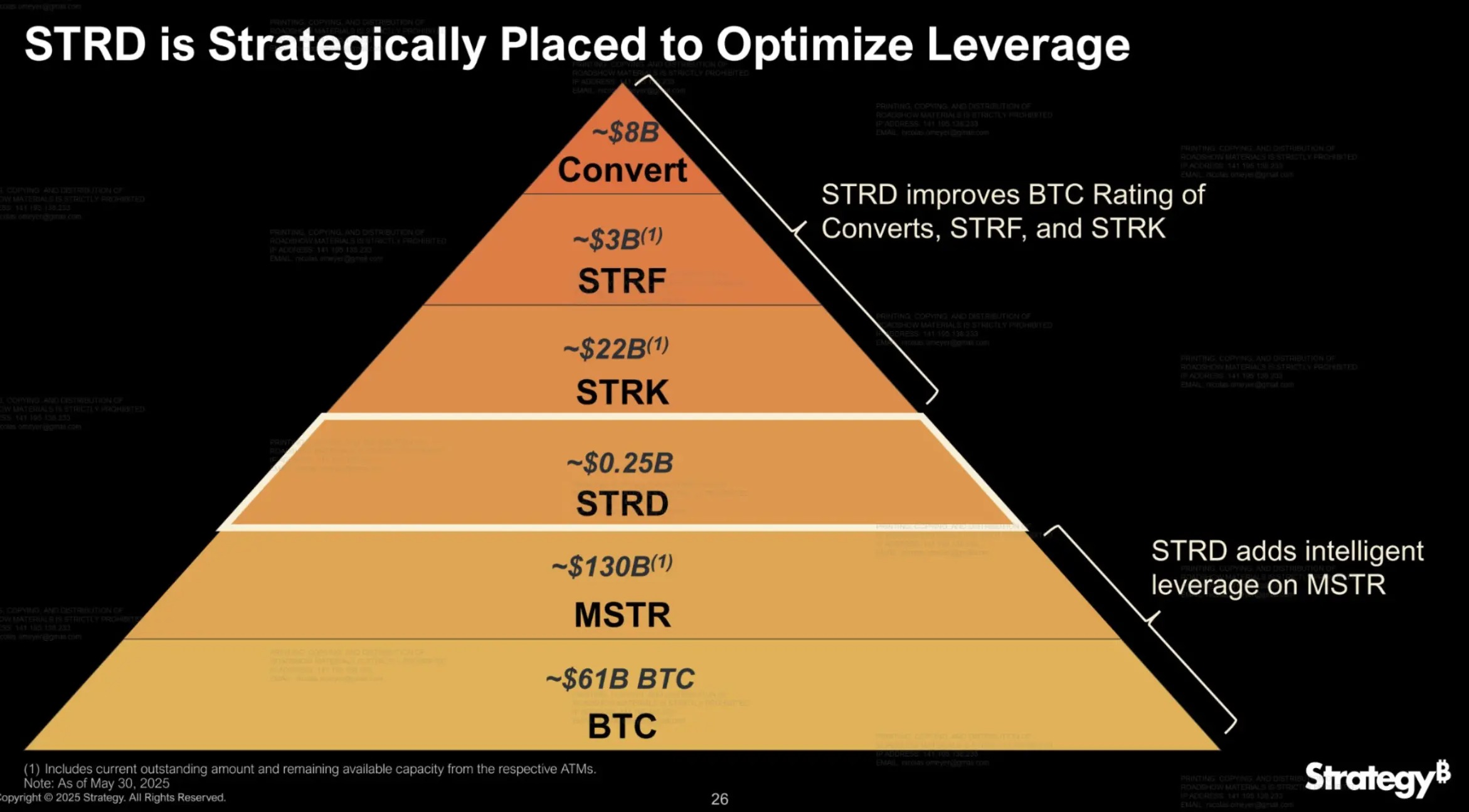作者:Fairy,ChainCatcher
Strategy 又出新招了。
为持续加码比特币头寸,微策略近年来频频「造血」,从普通股、可转债到优先股,三路并进,融资不断。
牛市未尽,筹码加倍。昨日,Strategy 宣布推出全新优先股产品 STRD,这是其比特币重仓路径上的又一张筹码。这张「新牌」有何不同?它的结构设计、潜在风险与市场博弈,又释放了哪些信号?
STRD:高息,但不保证到账
STRD 是 Strategy 推出的第三类优先股产品,拟公开发行 250 万股,所筹资金将主要用于比特币收购及营运资金补充。STRD 本质上是对 BTC 多头策略的又一次结构化表达,延续 STRK、STRF 的框架,又在收益分配与退出机制上做出新设计。
与前作类似,STRD 背后的底层资产依然是比特币,但这次 Strategy 采取了更「防守中进攻」的结构:年化票息为 10%,但不具备强制支付义务,且利息不累计。
加密 KOL Phyrex 解读一语中的:「STRD 的本质就是以 10% 的年息融资借钱给 Strategy ,但 Strategy 未必会按照承诺分发 10% 的年息,如果没有发,以后也不会补发。在说明中 Strategy 承诺了会按时发放,前提是企业盈利向好。」

至于这笔利息从何而来,Strategy 理论上有三种可能的支付路径:
-
出售 BTC 持仓:如果 Strategy 将部分持仓比特币变现,就能获得现金流,但这将面临资本利得税,且与其长期持有策略相悖。
-
持续融资滚动:可能通过再发行债务或其他工具筹钱来发利息,或许是 Strategy 目前更倾向的做法。
-
企业经营现金流:如果公司其他业务盈利,也可能用于支付利息。
虽然 Strategy 拥有不支付利息的权利,但这样做的代价将极为沉重。一旦停止发息,STRD 的市场价格势必承压,投资者信心受挫,未来再融资也将面临更大阻力。因此,市场普遍认为,只要比特币市场表现稳健,Strategy 大概率会选择按时履约,以维护其市场信誉及资金链的可持续性。
「三剑齐发」:Strategy 的多层次优先股
聊完 STRD 的特性后,不妨回过头来看 Strategy 当前的三款优先股产品。STRK、STRF 与 STRD 在清算顺位、收益设计、风险结构上各有定位,构成 Strategy 多层资本结构的关键拼图。以下是 Bitwise 高级投资策略师 Juan Leon 整理的三种产品对比表(表格内容由 ChainCatcher 翻译):

从投资者适配角度来看,STRK 更契合追求稳健收益、风险偏好较低的保守型配置需求;STRF 面向期望锁定较高固定收益、但可接受一定信用风险的中性投资者;STRD 则聚焦于风险容忍度高的进攻型资金。
除了产品层面的延展,STRD 的推出或许也是 Strategy 对资本结构底盘的一次加注。据社区成员 @DogCandles 分享的图表显示,STRD 「地位低」,但「作用大」,通过改善上层产品的信用支持,优化整体资本结构。

社区不买账,STRD 争议四起
STRD 的发布是 Strategy 精心设计的一步棋,但社区却并不一致叫好。许多声音直指其「资本魔法」:
-
@chaojidigua:姜太公钓鱼, 愿者上钩。
-
@MemeSiguoyi:别看币圈可以空气币印钱,俺们股票也有自己的虚空印钱大法。
-
@Softelectrock:庞氏套娃。
《比特币时代》作者 Adam Livingston 直接点破:STRD 本质上是一个伪装成收益工具的 BTC 增持期权。BTC 大涨时,Strategy 按面值赎回;BTC 大跌时,直接不发息。投资者实际上是在为他的「比特币终极采纳」信仰买单。
而 Metaplanet 比特币战略总监 Dylan LeClair则从结构角度称其「天才设计」:「STRD 的发行实际上提升了 STRF 的信用质量。」
关于 Strategy 的未来发展路径,加密 KOL Phyrex 则给出更大胆的预测:「有可能 Strategy 会做一些库存 Bitcoin 的打算,比如将 BTC 借贷出去,比如参与一些量化交易,来维持现金流,Strategy以后可能会变成一家基于 BTC 的银行。」

Strategy 的筹码已推至牌桌中央。用结构化产品包裹信仰,用风险收益模型掩盖单边押注,用「高息」吸引市场情绪。
这场以信仰为底的金融实验,正变得越来越复杂,也越来越值得关注。
免责声明:本文章仅代表作者个人观点,不代表本平台的立场和观点。本文章仅供信息分享,不构成对任何人的任何投资建议。用户与作者之间的任何争议,与本平台无关。如网页中刊载的文章或图片涉及侵权,请提供相关的权利证明和身份证明发送邮件到support@aicoin.com,本平台相关工作人员将会进行核查。




